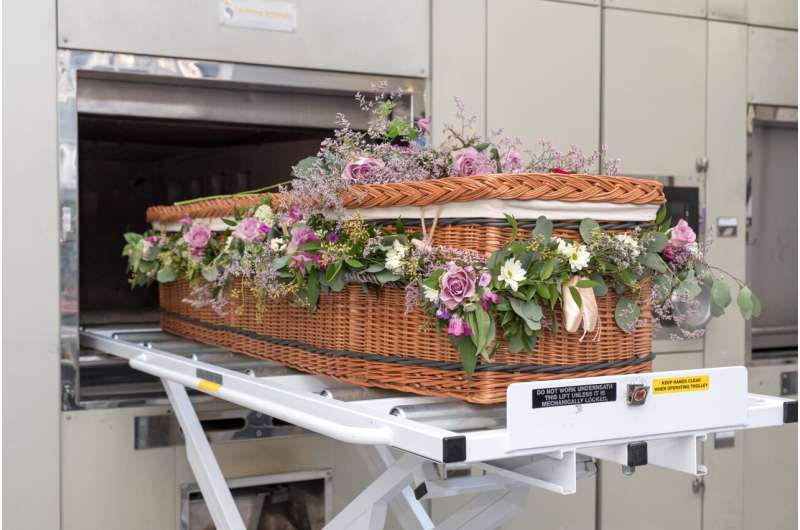American individualism lives on after death, as consumers choose new ways to put their remains to rest

Death may be inevitable and universal, but the ways people deal with it most certainly are not. Whether doing , attending a graveside service dressed in black or putting one's parents' ashes , each culture has its own ways to deal with death and mourning.
Yet death rites around the world do share some common goals. Traditionally, what happens to a dead body reflects communal beliefs and practices—rituals not only meant to honor the deceased but also to comfort their community.
Increasingly, however, people in the United States are choosing unconventional ways to dispose of their bodies. Today, fans of music might have their cremated remains . Wannabe astronomers can be .
In â€Äì°ù´Ç³¾ and lurid true crime cases to —I have found that many Americans are more attracted to sensational portrayals of mortality than realistic ones.
Similarly, I believe these new funeral practices present death as a fantastic, personalized adventure, rather than something natural and inevitable. They emphasize the power of the individual consumer—up to and including the last purchase they'll ever make.
Comfort and community
Even when expected, death is always upsetting, unsettling mourners' sense of normalcy. One important function of death rituals is to help survivors process their grief and reestablish order.
Many funerary rituals also emphasize the immortality of the deceased, whom they depict as entering another realm of existence. , this journey might require the community to burn the body, leave it exposed to carrion animals, bury it or mummify it.
Christians in the United States have long practiced earth burial, gathering at the graveside to witness their loved one's final interment. A minister preaches about the soul, which in this faith is believed to transcend the body and spend eternity in a heavenly afterlife—providing that the person lived a life in line with religious dictates.
Christian teachings that Jesus will ultimately on Judgment Day, not just their souls, helped shape standards of funeral practices, including embalming and casketing an intact body. These religious beliefs also influenced the emergence of in the U.S.
Long-term shifts
For decades, though, American norms around death and funerals have been changing.
While the nation's majority is still Christian, religious diversity has grown significantly. About 6% of Americans , and , according to the Pew Research Center. More Americans than ever before count themselves among the "spiritual but not religious."
Christianity's decreasing dominance has helped give rise to new ways of handling death—including among Christians. Half of the people who die in the U.S. each year , of bodily disposal for communities like Japanese Buddhists and South Asian Hindus.
But the increasing costs of burials have also made cremation a more attractive option for people from other religions. Among Christians, Protestants embraced the practice before Catholics, as the Vatican . Yet cremated Christians may still opt to include other long-standing funeral practices into their memorial services, such as reading biblical passages and using Christian symbols on urns and other mementos.
Ordering your afterlife
It is not just practices around death that have been changing, though, but attitudes.
Beginning in the 20th century, with the decrease in handling dead bodies at home, Americans grew increasingly uncomfortable with the contemplation of their own death. As my research on the popularity of , and has shown, many people prefer to think about mortality as a phenomenon that happens to others, often in spectacular and even entertaining ways.
that with the decline in religious beliefs, death had become unbearable to think about—even death-bed scenes in literature had grown scarcer, he said. Instead, Gorer argued, depictions of death had become like pornography: something natural made taboo, a guilty pleasure, and represented in an unnatural light.
Today's popularity of superhero and gangster films featuring violent deaths, or horror movies filled with otherworldly monsters, shows just how right he was. Death from natural causes, on the other hand, is typically shielded from view. Even the "Barbie" movie, which features a montage depicting what it means to be human, shies away from showing dying, grief or loss.
On an individual level, too, some Americans are opting to handle their remains in new ways, including methods that feel removed from the reality of death and decomposition. Rather than being planted under a field of green grass, for example, people who enjoyed hunting can choose to have their cremains —fantasizing their continued identity as killers. Those preferring a less aggressive finish might have their cremains . A trace of carbon remains after bodies have been burned, and numerous companies will take that small bit and purify enough out of it to form a sparkly jewel.
Wearable memorial tokens actually have origins in the Victorian era. England's Queen Victoria became following the death of her husband, Prince Albert, whose hair she had fashioned into jewelry. During the era, locks from the dead were woven into designs, placed in frames and worn as pendants.
Traditional mourning jewelry, therfore, was a visible reminder of death, with the loved one's hair on display. , on the other hand, offer mass-marketed gemstones to a consumer public and look indistinguishable from any other jewelry, effectively hiding their relation to the dead body.
Lest jewelry seem too materialistic, nature lovers can request that they be after death. The variety of products using hair and ashes keeps growing: creates glass sex toys that house customers' cremains, while other services will package ashes or .
But despite these secular, consumer-based, highly individualized options reflecting the move away from traditional religious explanations for death, I believe each one still appeals to a desire for immortality. In that sense, they connect to a universal human longing to live on—as people who remain active, present and vital, even in death.
Provided by The Conversation
This article is republished from under a Creative Commons license. Read the .![]()





















